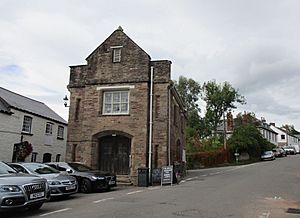Grosmont, Monmouthshire facts for kids
Quick facts for kids Grosmont |
|
|---|---|
 Grosmont from the south east |
|
| Principal area | |
| Ceremonial county | |
| Country | Wales |
| Sovereign state | United Kingdom |
| Post town | USK |
| Postcode district | NP |
| Police | Gwent |
| Fire | South Wales |
| Ambulance | Welsh |
| EU Parliament | Wales |
| UK Parliament |
|
Grosmont is a small village in Monmouthshire, Wales. Its Welsh name is Y Grysmwnt or Rhosllwyn. In 2011, about 920 people lived here. The area around Grosmont also includes the villages of Llangattock Lingoed, Llangua, and Llanvetherine. Some clues suggest Grosmont might have started as an Iron Age camp a very long time ago.
Contents
Exploring Grosmont's Past
Grosmont Castle: A Norman Stronghold

Grosmont Castle is a historic building in the village. It was built by the Normans after they invaded England in 1066. This castle is part of the famous Three Castles Walk. This walking path connects Grosmont Castle with two other nearby castles: White Castle and Skenfrith Castle. The castle was also the birthplace of Henry, 1st Duke of Lancaster, an important historical figure.
Grosmont's Medieval Town Life
Grosmont was once a very important town in the Middle Ages. It received a special permission, called a borough charter, possibly in 1219. This meant it could govern itself more. By 1250, there were many plots of land for houses, showing how big the town was. Grosmont kept its special town status until 1857. Even then, it still had a mayor and an official person to taste the local ale (beer)!
The Grosmont Town Hall was built in 1832. It replaced an older building made of wood. The Duke of Beaufort, a powerful landowner, built it. Later, his family offered it to the local council in 1902.
The Church of St Nicholas
The Church of St Nicholas is very old. Its tower and other parts were built by Prince Edmund, the son of King Henry III of England. He built it for his mother, Queen Eleanor of Provence. The church is from the 1300s and is dedicated to St Nicholas. It was repaired in 1869 and has a unique eight-sided tower.
The Battle of Grosmont (1405)
Grosmont played a role in the Welsh rebellion led by Prince Owain Glyndŵr. In 1405, a big battle happened here. Owain Glyndŵr's captain, Rhys Gethin, led about 8,000 men to Grosmont. They attacked the town and burned it down. At that time, Grosmont was a large and important settlement. Only Abergavenny and Carmarthen were bigger in South Wales.
Prince Henry, who later became King Henry V, sent his soldiers from Hereford. They met the Welsh force and defeated them. Between 800 and 1,000 Welsh soldiers were killed. Two of Glyndŵr's important allies were captured and sent to the Tower of London.
Grosmont in Recent Times
In the 1820s, a religious leader named Lydia Sellon grew up in Grosmont. She later started a religious group for women.
In 2006, the village and its local pub were used for filming a movie called The Baker. The Angel public house in Grosmont was owned by a group of villagers until 2014.
Getting Around Grosmont
Grosmont is located near the Pontrilas railway station in Herefordshire. This station is currently closed. It is on the Welsh Marches Line, which runs between Abergavenny and Hereford.




